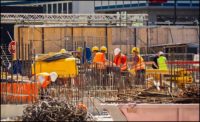My most recent columns have provided specific details from the LEED program pilot resilience credits. These credits are for single buildings and are to be implemented as part of the design process. But, what about the bigger picture of societal resilience and how that ties into the decisions that must be made for individual buildings? The U.K. is in the process of finalizing a new national resilience strategy that was intended to be published in March 2022. The U.K. government is attempting to develop a strategy that not only identifies what the national government should do but defines local and broader guidelines for building designers and/or owners, as well as the general public.
The process of developing the national resilience strategy started with a “Call for Evidence,” where the government solicited input from the public regarding the direction and priorities for this new strategy. In addition to laying out the issues, responses to specific questions were requested. These questions were divided into six broad categories: risk and resilience, responsibilities and accountability, partnerships, community, investment, and resilience in an interconnected world. In addition, two questions considered the plan’s overall vision and principles. The results of the call for evidence are summarized in a publicly available report. Although the complete documents should be of interest to everyone, and reading the full reports is highly recommended, this column will focus on a few items that relate more directly to the design community.
The risk and resilience questions focused on the national government’s role in quantifying risk. The responses identified better risk assessment and communication as top priorities. This aligns very well with the design of buildings and building systems for enhanced resilience. The more accurate the risk assessments for various hazards, the better the desired response to those hazards can be designed and implemented. Communicating the risks in a clear, consistent, and transparent method also assists designers. Too often, finding and interpreting information about hazards beyond the code-required level is more difficult than it needs to be. An excellent example of this is predicting temperature increases. As discussed in an earlier column, design data are based on historical records with no projection into the future. There are multiple sources for future temperature at various locations, but they are contradictory, and it is problematic for a designer to choose which one is best suited for their application.
The section on partnerships is of particular interest. As various government authorities, public interest, and private groups work together on defining resilience goals, and working toward those goals, will have a great impact on whether or not the desired enhanced resilience is achieved. The descriptions and questions address areas, such as defining what is critical national infrastructure, and are further expanded to include essential industries, sensitive technology, and supply chain issues. There was wide consensus amongst the respondents to the call for evidence that standards and regulations can help to improve resilience. The thought is that standardization can assist in two ways: providing guidance and improving response after an event, since the parts will have been designed to work together.
The section on investment is obviously of great importance, since government spending can strongly influence not only government response but the activities of the private sector through the setting of priorities, matching funds, etc. The call for evidence discusses determining where in the risk cycle further investments should be allocated. In addition to discussing prevention, emphasis is placed on developing adaptive response capabilities. That is, investing in projects that can respond to multiple hazards. Although the summary of the call for evidence responses does not address investment directly, other sources suggest greater emphasis is being placed on preparation rather than prevention. Both are needed, and the exact mix will depend on the hazards involved, the scope of the project (community versus individual building), and the need for a particular asset after an event.
In my previous columns, the need for both prevention (the design of systems to resist extreme events) and preparation (plans for continued operation and/or recovery) have been detailed. It is up to the building owner, with guidance from the design team and following any community-developed requirements, to determine where to invest his or her time and money to obtain enhanced resilience. The new U.K. national resilience strategy shows that governments are taking a holistic approach to the problem, considering the needs of the community as a whole as well as the private sector. The identification of risk evaluation and the need for standards and guidelines is a positive development. Both can lead to a more realistic determination of the costs and benefits of any particular resilience effort, and, in the long run, provide useful information for designers.





